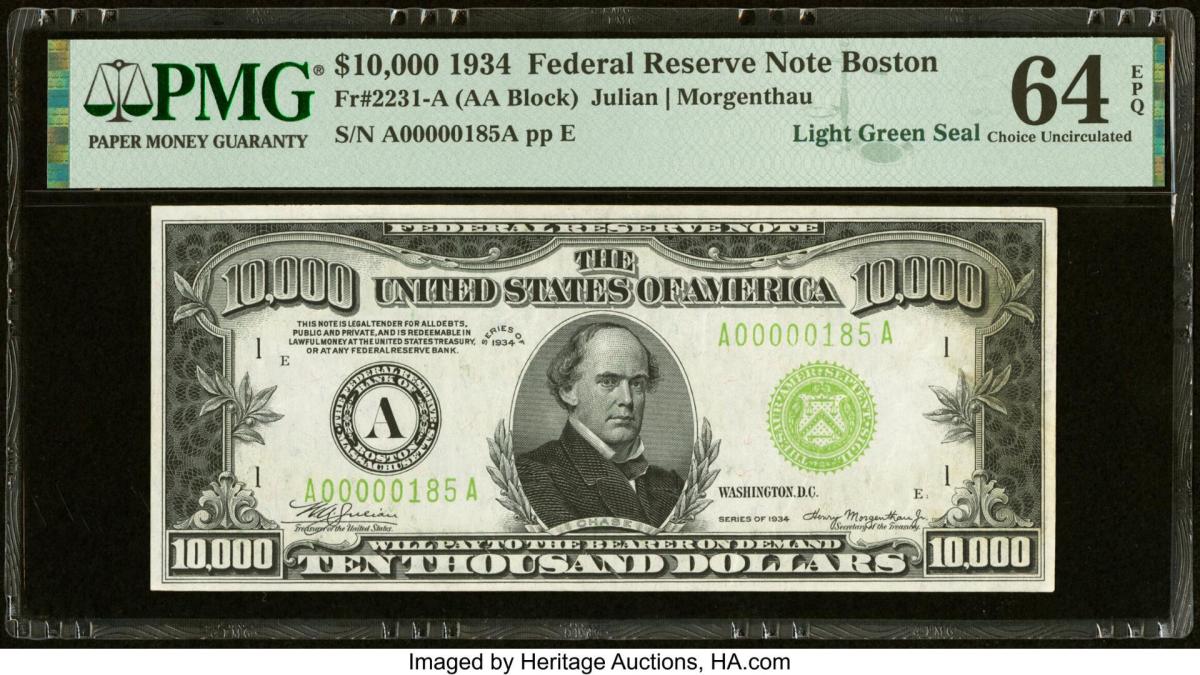
Hey, buddy, can you break a $10,000 bill?
If you can't, don't worry about it. These big bills have been out of circulation since the Nixon administration.
DON'T MISS: Ford surges on reports UAW will signal pay talk progress ahead of strike deadline
And since they're so rare, people are willing to pay a lot of money for this kind of money.
Rare $10,000 Bill Dating Back to the Great Depression Sells for $480,000: 'An Absolute Prize' https://t.co/dYp9nG3mVM
— People (@people) September 21, 2023
This happened recently at the Long Beach Expo US Currency Signature Auction in Dallas, where a $10,000 bill dated 1934 was sold at auction earlier this month for a stunning $480,000.
Now, all you notaphilists — collectors of paper money or banknotes — take note.
This bill was issued during the Great Depression, when the average annual income was $1,368 and when 10,000 bucks would be the equivalent of nearly $230,000 today.
Drawing the interest of collectors
“Large-denomination notes always have drawn the interest of collectors of all levels," Dustin Johnston, vice president of currency at Heritage Auctions, said in a statement.
"The $10,000 trails only the $100,000 gold certificate issued in 1934, and of the 18 examples graded by PMG, this example is tied for the highest-graded.”
PMG has graded only four other small-sized $10,000 Federal Reserve notes and only five higher, Johnston said, "so this is an absolute prize that will command a share of the spotlight in its new collection home.”
Other items sold at the auction included an 1899 $20 gold coin that sold for $468,000 and a $5,000 bill from 1934 that went for $300,000.
Salmon P. Chase on the $10K: Who Was He?
The $10,000 bill bears the image of Salmon P. Chase and you may be asking yourself: Who is this guy Chase and why is his face appearing in this prestigious place?
Well, he was the Treasury Secretary in Abraham Lincoln’s administration. He was the 23rd governor of Ohio and had also represented the state in the U.S. Senate. And Chase was the sixth chief justice of the Supreme Court, where he presided over the impeachment of President Andrew Johnson in 1868.
In fact, prior to his appointment to the high court, Chase was widely seen as a potential presidential candidate himself.
Chase, who died in 1873, also introduced the modern system of banknotes, and he is depicted on the $10,000 bill to honor this achievement.
In addition, he was instrumental in placing the phrase "In God We Trust" on U.S. coins, in 1864.
The highest denomination of U.S. currency
The $10,000 bill was the highest denomination of U.S. currency to circulate publicly.
A $100,000 bill, featuring the portrait of Woodrow Wilson, was issued, but, according to the Museum of American Finance, it was used only to transfer funds between Federal Reserve Banks.
U.S. currency denominations above $100 are not available from the Department of the Treasury, the Federal Reserve System, or the Bureau of Engraving and Printing.
In 1969, the government pulled from circulation the $10,000 bill and any other denominations $500 and higher due to lack of use. While these notes were issued until 1969, they were last printed in 1945.
Collectibles & Currencies, which describes itself as "a destination for banknote collectors," said on its website that "collecting U.S. paper money is an opportunity to learn about the country's history and the lives of those who lived before us."
"It is a way to recognize the accomplishments and passions of past generations and preserve that history for future generations," the Sacramento, Calif., company said.
"Regardless of what one chooses to collect, U.S. paper money offers a unique window into the past, making it a truly fascinating hobby."
Action Alerts PLUS offers expert portfolio guidance to help you make informed investing decisions. Sign up now.







